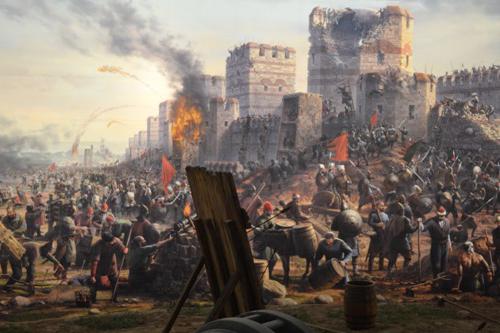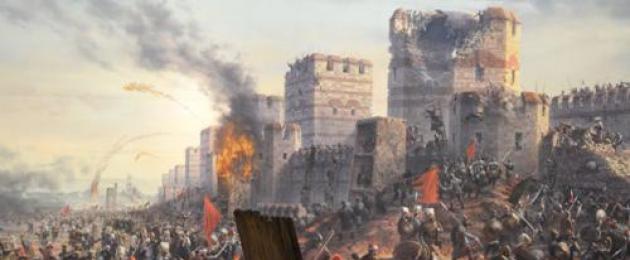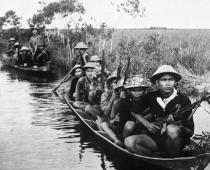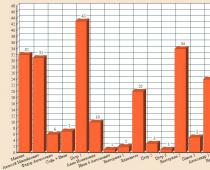In the XIII century, all the peoples who inhabited Kievan Rus had to repel the invasion of Batu Khan's troops in a hard struggle. The Mongols were on Russian soil until the 15th century. And only during the last century the struggle was not so cruel. This invasion of Batu Khan into Russia directly or indirectly contributed to the rethinking of the state structure of the future great power.
Mongolia in the 12th - 13th centuries
The tribes that were part of it united only at the end of this century.
This happened thanks to Temuchin, the leader of one of the peoples. In 1206, a general assembly was held, in which representatives of all nations took part. At this meeting, Temujin was proclaimed a great khan and given the name Genghis, which means "limitless power" in translation.
After the creation of this empire, its expansion began. Since the main occupation of the inhabitants of Mongolia at that time was nomadic cattle breeding, it was natural for them to want to expand their pastures. It was one of the main reasons for all their combat wanderings.
Organization of the Mongols
The Mongolian army was organized according to the decimal principle - 100, 1000 ... The creation of the imperial guard was carried out. Its main function was to control the entire army. The Mongols' cavalry was more trained than any other nomadic army in the past. The Tatar conquerors were very experienced and excellent warriors. Their army consisted of a large number of warriors who were very well armed. They also used tactics, the essence of which was based on the psychological intimidation of the enemy. In front of their entire army, they let in those soldiers who did not take anyone prisoner, but simply brutally killed everyone indiscriminately. These warriors had a very intimidating appearance. Another significant reason for their victories was that the opponent was completely unprepared for such an offensive.
The presence of the Mongolian army in Asia
After the Mongols conquered Siberia at the beginning of the 13th century, they began to conquer China. They took out from the northern part of this country the latest military equipment and specialists for that century. Some Chinese representatives became very literate and experienced officials of the Mongol Empire.

Over time, Mongolian troops conquered Central Asia, Northern Iran and Transcaucasia. On May 31, 1223, a battle took place between the Russian-Polovtsian army and the Mongol-Tatar army. Due to the fact that not all the princes who promised help kept their promise, this battle was lost.
The beginning of the reign of Khan Batu
4 years after this battle, Genghis Khan died, Ogedei took his throne. And when the decision was made by the government of Mongolia to conquer the western lands, the nephew of the Khan, Batu, was appointed the person who would lead this campaign. One of the most experienced commanders, Subedei-Bagatur, was appointed as commander of the troops under Batu. He was a very experienced one-eyed warrior who accompanied Genghis Khan during his campaigns. The main goal of this campaign was not only to expand its territory and consolidate success, but also to enrich, replenish its bins at the expense of plundered lands.
The total number of Batu Khan's troops, which went on such a difficult and long journey, was small. Since part of it had to remain in China and Central Asia to prevent the uprising of local residents. A 20,000-strong army was organized for the march to the West. Thanks to mobilization, during which the eldest son was taken from each family, the number of the Mongol army increased to about 40 thousand.
The first path of Batu

The great invasion of Khan Batu into Russia began in 1235 in winter. Batu Khan and his commander-in-chief did not just choose this time of year to launch their attack. After all, winter began in November, the season when there is a lot of snow around. It was he who could replace the soldiers and their horses with water. At that time, the ecology on our planet was not yet in such a deplorable state as it is now. Therefore, snow could be used without looking back anywhere in the world.
After crossing Mongolia, the army went to the Kazakh steppes. In summer it was already on the shores of the Aral Sea. The path of the conquerors was very long and difficult. Every day this huge mass of people and cavalry traveled a distance of 25 km. In total, it was necessary to overcome about 5,000 km. Therefore, the batyrs came to the lower reaches of the Volga only in the autumn of 1236. But even here they were not destined to rest.
After all, they remembered very well that it was the Volga Bulgars who defeated their army in 1223. Therefore, they defeated the city of Bulgar, destroying it. They ruthlessly slaughtered all its inhabitants. The same part of the townspeople that remained alive simply recognized the power of Batu and bowed their heads before His Majesty. Representatives of the Burtases and Bashkirs, who also lived near the Volga, submitted to the invaders.
The beginning of the Batu invasion of Russia

In 1237, Batu Khan crossed the Volga with his troops. His army left a lot of tears, destruction and grief on its way. On the way to the lands of the Russian principalities, the Khan's army was divided into two military units, each of which numbered about 10,000 people. One part went to the south, to where the Crimean steppes were located. There, the Butyr army pursued the Polovtsy Khan Kotyan and pushed him closer and closer to the Dnieper. This army was headed by Möngke Khan, who was the grandson of Genghis Khan. The rest of the army, led by Batu himself and his commander-in-chief, headed in the direction where the borders of the Ryazan principality were located.
In the 13th century, Kievan Rus was not a single state. The reason for this was its disintegration at the beginning of the XII century into independent principalities. They were all autonomous and did not recognize the power of the Prince of Kiev. In addition to all this, they also constantly fought among themselves. This led to the death of a large number of people and the destruction of cities. This state of affairs in the country was typical not only for Russia, but for Europe as a whole.
Batu in Ryazan
When Batu was on the lands of Ryazan, he sent his ambassadors to the local government. They conveyed to the Ryazan commanders the demand of the Khan for the issuance of food and horses to the Mongols. Yuri, the prince who ruled in Ryazan, refused to obey such extortion. He wanted to answer Batu with a war, but in the end, all the Russian squads fled as soon as the Mongol army went on the attack. The Ryazan warriors hid in the city, while the khan surrounded it at that time.
Since Ryazan was practically unprepared for defense, she managed to hold out for only 6 days, after which Batu Khan and his army took it by storm at the end of December 1237. Members of the princely family were killed and the city was sacked. The city at that time was only rebuilt after it was destroyed by the prince of Suzdal Vsevolod in 1208. Most likely, this was the main reason that he could not fully resist the Mongol attack. Khan Batu, whose brief biography consists of all the dates that denote his victories in this invasion of Russia, once again celebrated the victory. It was his first, but by no means his last victory.
Khan's meeting with Vladimir prince and Ryazan boyar

But Batu Khan did not stop there, the conquest of Russia continued. News of his invasion spread very quickly. Therefore, at the time when he held Ryazan under his control, the prince of Vladimir had already begun to gather an army. At its head, he put his son, Prince Vsevolod, and the governor Yeremey Glebovich. This army included regiments from Novgorod and Chernigov, as well as that part of the Ryazan squad that survived.
Near the city of Kolomna, which is located in the floodplain of the Moscow River, there was a legendary meeting of the troops of Vladimir with the Mongolian. It was January 1, 1238. This confrontation, which lasted 3 days, ended with the defeat of the Russian squad. The chief governor died in this battle, and Prince Vsevolod fled with part of his squad to the city of Vladimir, where Prince Yuri Vsevolodovich was already waiting for him.
But before the Mongol invaders had time to celebrate their victory, they had to fight again. This time, Evpaty Kolovrat, who at that time was just a boyar from Ryazan, spoke out against them. He had a very small but courageous army. The Mongols managed to defeat them only due to their superiority in numbers. The governor himself was killed in this battle, but Batu Khan released those who survived. By this he expressed his respect for the courage shown by these people.
The death of Prince Yuri Vsevolodovich

After these events, the invasion of Batu Khan spread to Kolomna and Moscow. These cities, too, could not withstand such a huge force. Moscow fell on January 20, 1238. After that, Batu Khan moved with his army to Vladimir. Since the prince did not have enough troops for a good defense of the city, he left part of it together with his son Vsevolod in the city in order to protect it from the invaders. He himself, with the second part of the soldiers, left the glorious city in order to gain a foothold in the forests. As a result, the city was taken, the entire princely family was killed. Over time, the envoys of Batu accidentally found Prince Yuri himself. He was killed on March 4, 1238 on the River City.
After Batu took Torzhok, whose inhabitants did not wait for help from Novgorod, his troops turned south. They still advanced in two detachments: the main group and a couple of thousand horsemen, led by Burundai. When the main group tried to storm the city of Kozelsk, which was in their way, all their attempts did not bring any result. And only when they united with the Burundai detachment, and only women and children remained in Kozelsk, the city fell. They completely razed this city to the ground along with everyone who was there.
But still the forces of the Mongols were undermined. After this battle, they quickly marched to the lower reaches of the Volga in order to rest and gain strength and resources for a new campaign.
The second campaign of Batu to the West
After a short rest, Batu Khan set out on his campaign again. The conquest of Russia was not always easy. The inhabitants of some cities did not want to fight with the khan and preferred to negotiate with him. In order for Batu Khan not to touch the city, some simply bought their lives with the help of horses and provisions. There were those who went to serve him.
During the second invasion, which began in 1239, Batu Khan again robbed those territories that had fallen during his first campaign. New cities were also captured - Pereyaslavl and Chernihiv. After them, Kyiv became the main target of the invaders.

Despite the fact that everyone knew what Batu Khan was doing in Russia, confrontations between local princes continued in Kyiv. On September 19, Kyiv was defeated, Batu launched an attack on the Volyn principality. In order to save their lives, the inhabitants of the city gave the khan a large number of horses and provisions. After that, the invaders rushed towards Poland and Hungary.
The consequences of the invasion of the Mongol-Tatars
Due to the protracted and devastating attacks of Khan Batu, Kievan Rus lagged behind in development from other countries of the world. Its economic development was greatly delayed. The culture of the state also suffered. All foreign policy was focused on the Golden Horde. She had to regularly pay tribute, which Batu Khan assigned to them. A brief biography of his life, which was associated exclusively with military campaigns, testifies to the great contribution he made to the economy of his state.
Between scholars and historians in our time there is a dispute about whether these campaigns of Batu Khan preserved the political fragmentation in the Russian lands, or whether they were the impetus for the start of the process of unification of the Russian lands.
- In contact with 0
- Google+ 0
- OK 0
- Facebook 0








